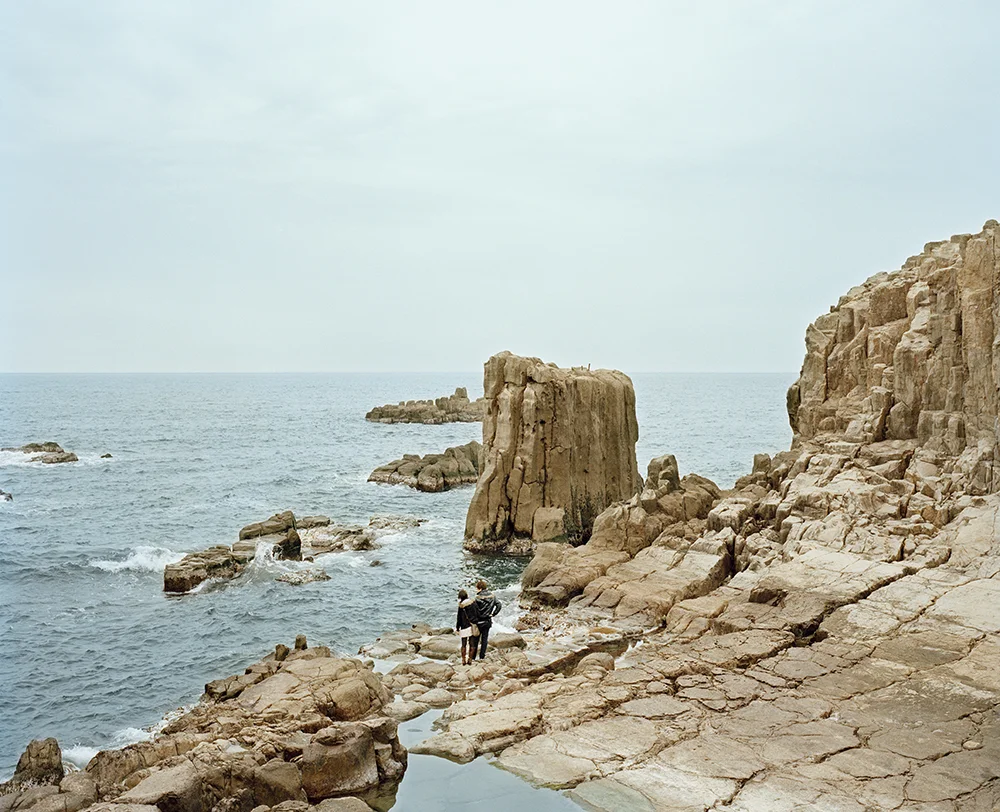Let's walk down and look at the sea. Emily Shur's Super Extra Natural!, featuring photographs made in Japan, begins with an image of about a dozen tourists spread across a rocky beach at Enoshima, standing and sitting, alone and in pairs. Shur observes from above and the figures are distant. A few individuals look up or down; most are facing the sea which, on this spit of land, commands the view in nearly every direction. In the foreground to one side is a white concrete staircase leading to the promontory, black metal posts beginning to rust, staining the concrete orange, bricked steps echoing the terrain below, cabled handrails leading into a cabled fence that partitions the viewing point from whatever lies outside of the frame. This foreground contextualization - the acknowledgment of a constructed "scenic view" – attests that the tourists' desire to stand before the sea extends far beyond this handful of persons. Society has something at stake in enabling this view.
Tourists – Enoshima 2010
Super Extra Natural! attends to the character of the everyday in Japanese cities, parks, and tourist attractions, and places in between, all coolly and carefully seen. Through a wide range of subjects Shur, in my reading, appears to be driven by one particular question: how can she visualize the relationship between nature and the built environment, where the latter is so often designed to honor the former, even as it seeks to control and contain it? We see this relationship proposed in so many ways: a swimming pool overlooks a misty forest, its clean lines and reflective surface contrasting with the depth of space beyond it. A backhoe sits in the middle of a rocky creek, part of some landscaping project, its shape and function clear but its goals unknown to us. In an otherwise concrete urban view, an enormous tree peeks out from behind a pedestrian overpass, so large as not to be concealable, so anomalous as to be invisible. Vines reach out across a wall overlooking a parking lot, the logic of the viny tendrils so different from that of the green and yellow parking dividers. Everywhere are traces of vegetation, in spite of the purpose of the place, or in accordance with it, and usually in some way both.
From the empty dining room of a ferry to a ramshackle gas station to the clouds floating between trees seen at Yakushima, Shur tunes in to the intersection of circumstance and cultural values expressed in aesthetics and design. She shows culturally-based concepts of nature in dialogue with other cultural priorities - urbanism, modernism - trying to resolve again and again, falling in and out of balance repeatedly as we glide through the book. The success of this book is the way in which Shur asks this question over and over again in graceful, subtle images made in many different situations.
Shur's familiarity with Japan was developed over sixteen visits to Japan over twelve years. She comes across as an outsider with an affinity for Japan that has been diligently nurtured into a substantial personal knowledge. Despite being given little specific information about Shur, a strong sense of her authorial persona comes through, a matter of style but also a matter of personality. Shur appears to be able to find, consistently, what she is looking for in the Japanese landscape.
With 135 photographs over 256 pages, Super Extra Natural! is a large book, and the rhythm of the book contains many sub-rhythms within. There are plays with color and form, including some understated visual puns. We are returned periodically to views of individuals going down to the sea. We are shown pigeons tearing into a bag of trash on a sidewalk and sudden, unexpectedly gorgeous views up through tall piny trees. Many of the photographs are informed by Western landscape traditions and by an attention to the ordinary that draws on Atget and Evans' legacies.
The overall effect, however, is that we are looking with Shur, and it’s her consistent sensibility that holds the book together. "Tourists – Enoshima 2010" is not only a picture of people looking at the sea, it is a picture about looking at people looking at the sea. Shur analyzes Japanese society as expressed in the relationship between nature and culture in its built environment, but it's the rhetoric of her analysis that is visually compelling, even moreso than the subjects of the photographs. Shur's visual decisions comprise a position statement, and the photographs are evidence of her way of looking. It's this way of looking that ties together all of these ordinary encounters, where Shur's familiarity and quiet questioning brings forth a sense of intimacy.
Osaka Station - Osaka 2015
One Swan- Mito 2010
Shrub Waves - Ushiku 2015
Tojinbo - Sakai 2011
Yoyogi Park - Tokyo 2014
Boy - Naoshima 2013








